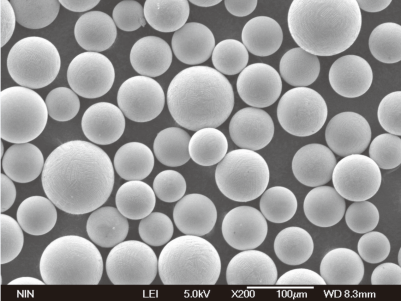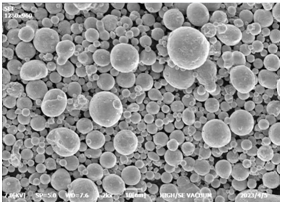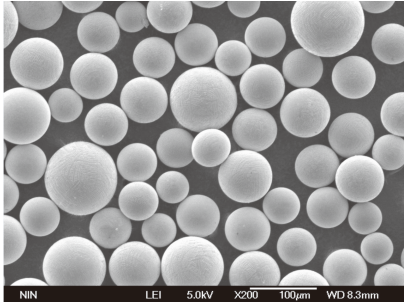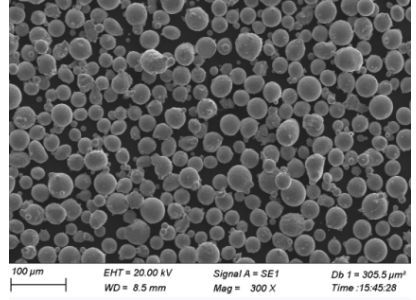Vue d'ensemble
Traitement post-atomisation le traitement des poudres métalliques est essentiel dans le processus de fabrication d'un grand nombre d'industries, de l'aérospatiale aux appareils médicaux. Ce processus améliore les propriétés des poudres métalliques, ce qui les rend plus adaptées à des applications spécifiques. Le traitement implique généralement des processus tels que le recuit, le tamisage et la modification de la surface afin d'améliorer la distribution de la taille des particules, la morphologie et la composition chimique.
Qu'est-ce que le traitement post-atomisation ?
Le traitement post-atomisation fait référence aux diverses méthodes appliquées aux poudres métalliques après qu'elles ont été produites par atomisation. L'atomisation est le processus par lequel le métal fondu est divisé en fines gouttelettes qui se solidifient ensuite en particules de poudre. Les traitements de post-atomisation sont essentiels pour améliorer les propriétés de la poudre, garantir la cohérence et améliorer les performances dans les applications finales.

Types de poudres métalliques et leur composition
Il existe différents types de poudres métalliques, chacune ayant une composition et des propriétés uniques adaptées à des applications spécifiques. Voici quelques-unes des poudres métalliques les plus couramment utilisées et leur composition :
| Poudre métallique | Composition | Propriétés |
|---|---|---|
| Acier inoxydable 316L | Fe, Cr, Ni, Mo | Résistance à la corrosion, haute résistance à la traction |
| Titane Ti6Al4V | Ti, Al, V | Rapport résistance/poids élevé, résistance à la corrosion |
| Aluminium 6061 | Al, Mg, Si | Léger, bonnes propriétés mécaniques |
| Alliage de cobalt et de chrome | Co, Cr, Mo | Résistance élevée à l'usure, excellente biocompatibilité |
| Alliage de nickel 625 | Ni, Cr, Mo, Nb | Haute résistance, excellente résistance à la corrosion |
| Acier maraging 18Ni300 | Fe, Ni, Co, Mo | Haute résistance, bonne ténacité |
| Alliage de cuivre C18150 | Cu, Cr, Zr | Haute conductivité, excellente résistance à l'usure |
| Carbure de tungstène | WC, Co | Dureté extrême, résistance à l'usure |
| Inconel 718 | Ni, Cr, Fe, Nb, Mo | Haute résistance, bonne résistance à l'oxydation |
| Alliage de bronze CuSn12 | Cu, Sn | Bonne résistance à la corrosion, excellente usinabilité |
Caractéristiques de la poudre pour le traitement post-atomisation
Les traitements post-atomisation sont conçus pour améliorer diverses caractéristiques des poudres métalliques. Voici quelques propriétés clés :
| Caractéristique | Description |
|---|---|
| Distribution de la taille des particules | Assure l'uniformité, ce qui influe sur la fluidité et la densité de l'emballage |
| Morphologie | Formes sphériques ou irrégulières affectant l'écoulement et l'emballage |
| Surface | Influence la réactivité et le comportement au frittage |
| La pureté | Des niveaux de pureté élevés réduisent le risque de contamination |
| Capacité d'écoulement | Influence sur la facilité de manipulation et de traitement |
| Densité apparente | Impacts sur l'efficacité de l'emballage et du frittage |
| Niveaux d'oxydation | Une oxydation plus faible améliore les performances dans les applications à haute température |
Applications de la poudre pour Traitement post-atomisation
Les propriétés améliorées des poudres métalliques post-atomisées leur permettent d'être utilisées dans une large gamme d'applications :
| application | Description |
|---|---|
| Aérospatiale | Composants légers et très résistants |
| Automobile | Pièces de moteur, composants de transmission |
| Dispositifs médicaux | Implants, instruments chirurgicaux |
| Secteur de l'énergie | Aubes de turbines, piles à combustible |
| Électronique | Encres conductrices, gestion thermique |
| Outillage | Outils de coupe, matrices |
| Fabrication additive (impression 3D) | Sur mesure, géométries complexes, prototypage |






Spécifications, tailles, qualités et normes
Lors de la sélection des poudres métalliques pour le traitement post-atomisation, il est important de prendre en compte les spécifications, les tailles, les qualités et les normes. Voici un tableau détaillé à titre de référence :
| Type de poudre | Gamme de tailles (µm) | Grade | Normes |
|---|---|---|---|
| Acier inoxydable 316L | 15-45, 45-105 | AISI 316L | ASTM A276, AMS 5653 |
| Titane Ti6Al4V | 15-45, 45-90 | 5e année | ASTM B348, AMS 4928 |
| Aluminium 6061 | 20-63, 63-125 | AA 6061 | ASTM B209, AMS 4027 |
| Alliage de cobalt et de chrome | 10-45, 45-90 | ASTM F75 | ISO 5832-4 |
| Alliage de nickel 625 | 15-53, 53-150 | UNS N06625 | ASTM B446, AMS 5666 |
| Acier maraging 18Ni300 | 10-45, 45-105 | Grade 300 | AMS 6514, ASTM A538 |
| Alliage de cuivre C18150 | 20-53, 53-150 | UNS C18150 | ASTM B606, RWMA Classe 2 |
| Carbure de tungstène | 5-15, 15-45 | Certifié ISO 9001 | ISO 9001, ASTM B777 |
| Inconel 718 | 15-45, 45-105 | UNS N07718 | ASTM B637, AMS 5662 |
| Alliage de bronze CuSn12 | 20-63, 63-150 | UNS C90700 | ASTM B505, AMS 4880 |
Fournisseurs et détails des prix
Le choix du bon fournisseur est crucial pour obtenir des poudres métalliques de haute qualité. Voici un aperçu de quelques fournisseurs et de leurs tarifs :
| Fournisseur | Localisation | Poudre métallique | Prix (USD/kg) |
|---|---|---|---|
| Hoganas AB | Suède | Acier inoxydable 316L | $50 – $70 |
| Technologie LPW | ROYAUME-UNI | Titane Ti6Al4V | $300 – $400 |
| Technologie des charpentiers | ÉTATS-UNIS | Aluminium 6061 | $25 – $40 |
| Arcam AB (GE Additive) | Suède | Alliage de cobalt et de chrome | $250 – $350 |
| Sandvik | Suède | Alliage de nickel 625 | $100 – $150 |
| GKN Hoeganaes | ÉTATS-UNIS | Acier maraging 18Ni300 | $150 – $200 |
| AMETEK Métal Spécialisé | ÉTATS-UNIS | Alliage de cuivre C18150 | $30 – $50 |
| Kennametal | ÉTATS-UNIS | Carbure de tungstène | $70 – $90 |
| Poudre métallique et processus | ÉTATS-UNIS | Inconel 718 | $200 – $250 |
| Fabrication de poudres métalliques | ROYAUME-UNI | Alliage de bronze CuSn12 | $20 – $35 |
Avantages et inconvénients de la poudre pour le traitement post-atomisation
Chaque poudre métallique présente ses propres avantages et limites. Voici un aperçu comparatif :
| Poudre métallique | Avantages | Limites |
|---|---|---|
| Acier inoxydable 316L | Résistant à la corrosion, haute résistance | Coût plus élevé que les autres aciers |
| Titane Ti6Al4V | Léger, très résistant | Coûteux, difficile à traiter |
| Aluminium 6061 | Léger, bonnes propriétés mécaniques | Résistance inférieure à celle de l'acier |
| Alliage de cobalt et de chrome | Haute résistance à l'usure, biocompatible | Coûteux, difficile à usiner |
| Alliage de nickel 625 | Excellente résistance à la corrosion, grande solidité | Coûteux, haute densité |
| Acier maraging 18Ni300 | Haute résistance, bonne ténacité | Coûteux, nécessite un traitement thermique |
| Alliage de cuivre C18150 | Haute conductivité, résistance à l'usure | Sujet à l'oxydation, moins résistant que l'acier |
| Carbure de tungstène | Extrêmement dur, résistant à l'usure | Fragile, coûteux |
| Inconel 718 | Haute résistance, bonne résistance à l'oxydation | Coûteux, difficile à usiner |
| Alliage de bronze CuSn12 | Bonne résistance à la corrosion, usinable | Résistance moindre par rapport à d'autres alliages |
Avantages de la poudre pour le traitement post-atomisation
Le traitement post-atomisation offre de nombreux avantages qui améliorent la qualité et les performances des poudres métalliques. Voici un aperçu détaillé de ces avantages :
Distribution améliorée de la taille des particules
Les traitements post-atomisation tels que le tamisage et la classification permettent d'obtenir une distribution granulométrique uniforme, ce qui est crucial pour obtenir des performances constantes dans des applications telles que la fabrication additive et la métallurgie des poudres.
Morphologie améliorée
Les traitements tels que le recuit et le traitement thermique peuvent améliorer la morphologie des particules de poudre, les rendant plus sphériques. Les particules sphériques s'écoulent mieux, se tassent plus efficacement et donnent des produits finis de meilleure qualité.
Réduction de la contamination
Les poudres de haute pureté avec une contamination minimale sont essentielles pour des applications telles que les dispositifs médicaux et les composants aérospatiaux. Les traitements de post-atomisation garantissent que les poudres répondent aux exigences de pureté les plus strictes.
Optimisation de la fluidité
Une bonne fluidité est essentielle pour les processus tels que l'impression 3D et le moulage par injection de métaux.
Les traitements post-atomisation améliorent les caractéristiques d'écoulement des poudres, garantissant un traitement fluide et fiable.
Niveaux d'oxydation contrôlés
Le contrôle des niveaux d'oxydation des poudres métalliques est essentiel pour les applications à haute température. Les traitements de post-atomisation permettent de réduire l'oxydation, améliorant ainsi les performances et la durée de vie des produits finis.
Spécifications, tailles, qualités et normes pour les poudres pour Traitement post-atomisation
Pour choisir la bonne poudre métallique, il faut tenir compte de diverses spécifications, tailles, qualités et normes. Voici une analyse détaillée :
| Poudre métallique | Gamme de tailles (µm) | Grade | Normes |
|---|---|---|---|
| Acier inoxydable 316L | 15-45, 45-105 | AISI 316L | ASTM A276, AMS 5653 |
| Titane Ti6Al4V | 15-45, 45-90 | 5e année | ASTM B348, AMS 4928 |
| Aluminium 6061 | 20-63, 63-125 | AA 6061 | ASTM B209, AMS 4027 |
| Alliage de cobalt et de chrome | 10-45, 45-90 | ASTM F75 | ISO 5832-4 |
| Alliage de nickel 625 | 15-53, 53-150 | UNS N06625 | ASTM B446, AMS 5666 |
| Acier maraging 18Ni300 | 10-45, 45-105 | Grade 300 | AMS 6514, ASTM A538 |
| Alliage de cuivre C18150 | 20-53, 53-150 | UNS C18150 | ASTM B606, RWMA Classe 2 |
| Carbure de tungstène | 5-15, 15-45 | Certifié ISO 9001 | ISO 9001, ASTM B777 |
| Inconel 718 | 15-45, 45-105 | UNS N07718 | ASTM B637, AMS 5662 |
| Alliage de bronze CuSn12 | 20-63, 63-150 | UNS C90700 | ASTM B505, AMS 4880 |
Analyse comparative : Types de poudres pour le traitement post-atomisation
Voyons maintenant une comparaison détaillée des différentes poudres métalliques :
Acier inoxydable 316L vs. titane Ti6Al4V
Acier inoxydable 316L est connu pour sa résistance à la corrosion et sa solidité. Cependant, Titane Ti6Al4V est plus léger et présente un rapport résistance/poids plus élevé, ce qui le rend idéal pour les applications aérospatiales et médicales où le poids est un facteur critique.
Alliage d'aluminium 6061 contre alliage de cobalt-chrome
Aluminium 6061 offre de bonnes propriétés mécaniques et est léger, mais il n'offre pas la résistance à l'usure et la biocompatibilité du Alliage de cobalt et de chromequi est préférée pour les implants médicaux et les applications dentaires.
Alliage de nickel 625 vs. acier maraging 18Ni300
Alliage de nickel 625 est excellent pour les environnements corrosifs et à haute température en raison de sa résistance supérieure à l'oxydation. D'autre part, Acier maraging 18Ni300 offre une résistance et une ténacité exceptionnelles, ce qui le rend adapté aux applications d'outillage et de structure.
Alliage de cuivre C18150 vs. carbure de tungstène
Alliage de cuivre C18150 excelle dans la conductivité électrique et la résistance à l'usure, ce qui le rend parfait pour les contacts électriques. En revanche, Carbure de tungstène est d'une dureté et d'une résistance à l'usure inégalées, idéal pour les outils de coupe et les pièces d'usure.
Inconel 718 vs. alliage de bronze CuSn12
Inconel 718 est préféré pour sa grande solidité et sa bonne résistance à l'oxydation dans les environnements extrêmes. Alliage de bronze CuSn12grâce à son excellente usinabilité et à sa résistance à la corrosion, il est couramment utilisé dans les roulements et les bagues.
Avis d'experts et études
Des études et des avis d'experts soulignent l'importance du traitement post-atomisation pour obtenir les propriétés souhaitées des poudres métalliques. La recherche indique qu'une distribution granulométrique et une morphologie optimisées ont un impact significatif sur les performances des poudres dans la fabrication additive et d'autres applications.
Par exemple, une étude de l'American Society for Testing and Materials (ASTM) souligne le rôle des traitements de post-atomisation dans la réduction de la porosité et l'amélioration des propriétés mécaniques des pièces imprimées en 3D. De même, les experts de la Fédération des industries des poudres métalliques (MPIF) soulignent la nécessité d'utiliser des poudres de haute pureté dans des applications critiques telles que l'aérospatiale et les appareils médicaux.

FAQ
| Question | Réponse |
|---|---|
| Qu'est-ce que le traitement post-atomique ? | Le traitement post-atomisation fait référence à des processus tels que le recuit, le tamisage et la modification de la surface appliqués aux poudres métalliques après l'atomisation afin d'améliorer leurs propriétés. |
| Pourquoi la distribution de la taille des particules est-elle importante ? | La distribution uniforme de la taille des particules garantit une fluidité constante, une densité d'emballage et des performances globales dans diverses applications telles que l'impression 3D et la métallurgie des poudres. |
| Quels sont les avantages de la morphologie sphérique des poudres ? | Les poudres sphériques s'écoulent mieux, se tassent plus efficacement et donnent des produits finis de meilleure qualité que les poudres de forme irrégulière. |
| Comment le traitement post-atomisation réduit-il la contamination ? | Des traitements tels que le tamisage et le traitement thermique permettent d'éliminer les impuretés et les contaminants, garantissant ainsi des poudres de haute pureté adaptées aux applications critiques. |
| Quelle est la meilleure poudre métallique pour les applications aérospatiales ? | Le titane Ti6Al4V est préféré pour son rapport résistance/poids élevé et son excellente résistance à la corrosion, ce qui le rend idéal pour les composants aérospatiaux. |
| Quels sont les principaux avantages de l'utilisation de l'alliage de nickel 625 ? | L'alliage de nickel 625 offre une grande solidité et une excellente résistance à la corrosion, en particulier dans les environnements corrosifs et à haute température. |
| Comment améliorer la fluidité des poudres métalliques ? | Les traitements post-atomisation, tels que le tamisage et le recuit, améliorent les caractéristiques d'écoulement des poudres, ce qui facilite leur manipulation et leur traitement. |
| Quelle est l'importance des niveaux d'oxydation dans les poudres métalliques ? | De faibles niveaux d'oxydation sont essentiels pour les applications à haute température, car ils améliorent les performances et la durée de vie des produits finis. |
| Les traitements post-atomisation peuvent-ils améliorer les propriétés mécaniques ? | Oui, des traitements tels que le recuit et le traitement thermique peuvent améliorer les propriétés mécaniques des poudres métalliques, ce qui les rend plus adaptées à des applications spécifiques. |
| Quelle est la meilleure poudre métallique pour les implants médicaux ? | L'alliage Cobalt-Chrome est couramment utilisé pour les implants médicaux en raison de sa grande résistance à l'usure et de son excellente biocompatibilité. |

